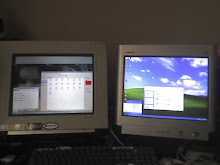Update 06-23-2018: According to https://www.barco.com/en/support/clickshare%20csc-1/knowledge-base/KB1191 users can use MirrorOp or the Google Cast extension to share screen
ClickShare is a neat way of presenting the content of your machine (and 3 others) without having to plug and unplug an HDMI cable. ClickShare, by Barco (https://www.barco.com/en/clickshare), requires a USB port to work. Simply plug in the USB adapter and run the .exe (MS Windows) or .dmg (macOS) file.
Unfortunately, back in December 2017, Barco stopped support for Linux clients (https://www.barco.com/en/support/clickshare%20csc-1/knowledge-base/KB1191).
Since a Slacker does not give up easily, I setup to install and run ClickShare on Slackware-current. Here are the steps I needed to follow to accomplish this task.
1) Download and install ffmpeg 2.1.5 (http://slackware.uk/slacky/slackware64-14.1/multimedia/ffmpeg/2.1.3/ may also do it) (ffmpeg 3.X does not work with ClickShare). This version of ffmpeg will allow the use of libswresample.so.2
Note: Even ffmpeg 2.8.6 will use libswresample.so.3 which will not work with ClickShare
2) Download the SlackBuild script for libresample from PhantomX (https://github.com/PhantomX/slackbuilds/tree/master/libresample). This will repackage libresample in 64-bit for your system. There are some libresample packages for Slackware, but for x86, not x86_64
Repackage libresample and install it
3) Download clickshare_01.07.01-79_amd64.deb (https://drive.google.com/drive/folders/0B9IKZqXvLKM_Yno1UmpGLVRXNDg)
This package was a bit harder to find, since Barco does not offer it anymore on its website
4) Decompress the contents and cp -a the content into the appropriate folders
5) Start ClickShare by typing clickshare in a terminal session or from your launcher
Regards,
F. Bobbio C.
Wednesday, June 20, 2018
Subscribe to:
Comments (Atom)
